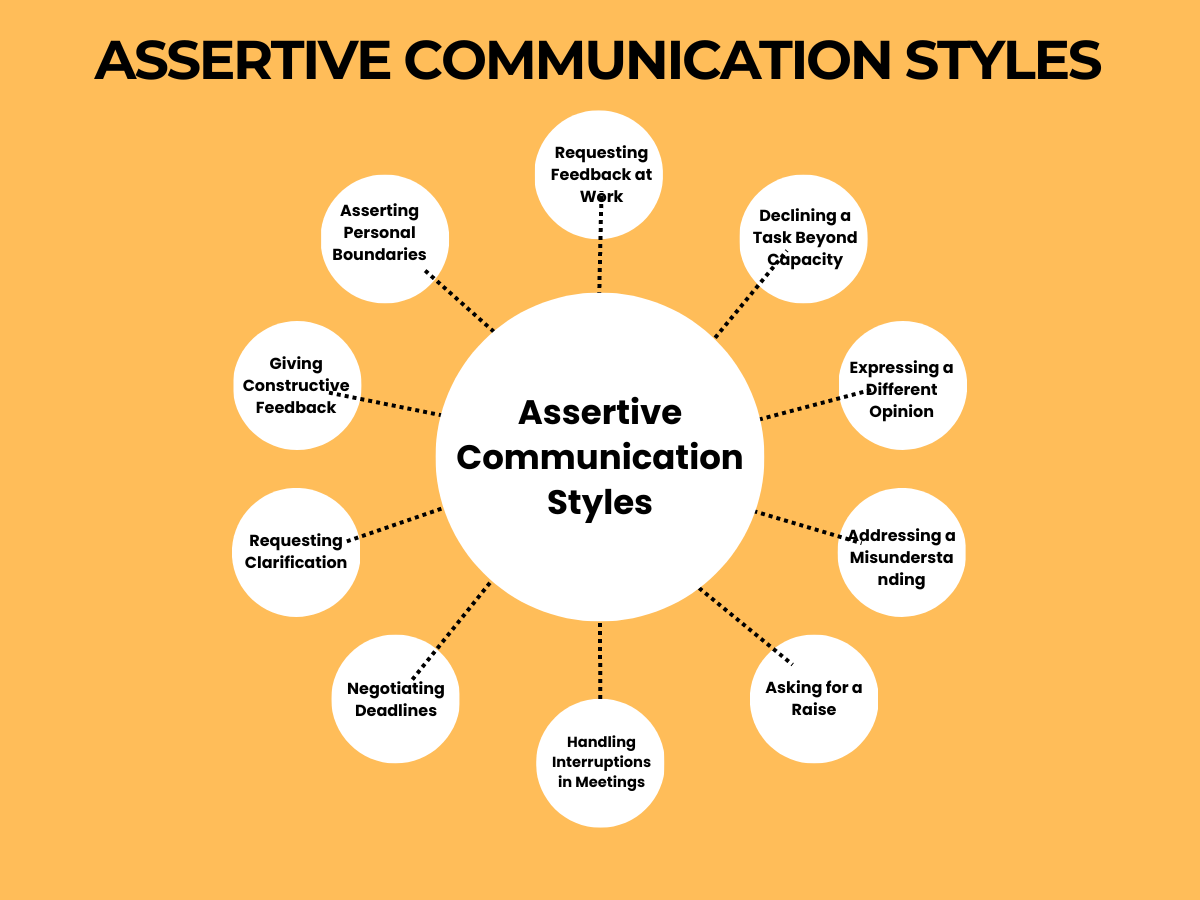Assertive Communication Styles
Assertive Communication Styles are key to effective oral communication. This guide provides a detailed exploration of various styles, offering real-life examples to enhance communication skills in different contexts. From workplace scenarios to personal interactions, understanding these styles empowers individuals to express themselves clearly and respectfully. This introduction, rich in SEO and NLP-friendly content, will guide readers through the nuances of assertive communication, emphasizing the importance of confidence and empathy in every conversation.
15 Assertive Communication Style Examples

Assertive communication style is essential for effective and respectful interaction in various settings. This guide provides 15 examples demonstrating how to utilize assertive communication effectively. Each example is designed to illustrate the application of this style in different contexts, from professional to personal environments. These examples showcase the ability to express oneself clearly and confidently while maintaining respect for others.
- Requesting Feedback at Work:
“I would appreciate your feedback on my recent project to understand areas for improvement.” Politely asking for constructive criticism. - Declining a Task Beyond Capacity:
“I’m currently at full capacity with my workload and won’t be able to take on this additional task.” Setting boundaries regarding workload. - Expressing a Different Opinion:
“I see your point, but I have a different perspective based on my experience.” Sharing an alternative viewpoint respectfully. - Addressing a Misunderstanding:
“There seems to be a misunderstanding here. Let me clarify my position.” Clarifying one’s stance to avoid confusion. - Asking for a Raise:
“Considering my achievements and market standards, I’d like to discuss a potential salary increase.” Confidently initiating a conversation about compensation.

- Handling Interruptions in Meetings:
“I’d like to finish my point before we move on to the next topic, please.” Assertively addressing interruptions. - Turning Down an Invitation Politely:
“Thank you for the invitation, but I am unable to attend.” Declining an offer gracefully. - Negotiating Deadlines:
“To ensure the quality of work, I propose extending the deadline to next week.” Negotiating deadlines for better output. - Voicing Discomfort in a Situation:
“I’m not comfortable with this approach and would like to discuss alternative options.” Expressing discomfort and seeking alternatives. - Requesting Clarification:
“Could you please provide more details on this point for better understanding?” Asking for more information to avoid misunderstandings. - Giving Constructive Feedback:
“Your work has been great, but there’s room for improvement in time management.” Providing feedback aimed at growth. - Asserting Personal Boundaries:
“I value our working relationship, but I need to set boundaries regarding work calls after hours.” Establishing personal boundaries at work.

- Rejecting Unacceptable Behavior:
“It’s not acceptable to speak to me in that tone. Let’s keep our communication professional.” Addressing and rejecting inappropriate behavior. - Advocating for a Team Member:
“I believe this team member has great potential and should be considered for the project.” Supporting a colleague’s capabilities. - Discussing Performance Review:
“I’d like to discuss my performance review and the reasons for these specific ratings.” Engaging in a dialogue about performance evaluation.
Assertive Communication Styles in the Workplace
Assertive communication in the workplace is key to fostering a positive and productive environment. This style of communication enhances team communication and leadership communication, ensuring clarity and respect in interactions. It involves expressing ideas and feedback confidently and constructively, leading to better decision-making and conflict resolution. In this guide, discover 10 examples of assertive communication in professional settings, each accompanied by explanations and example sentences. These instances demonstrate how to navigate workplace dynamics assertively, contributing to effective internal communication and a healthier work culture.
- Addressing Overdue Work:
“I’ve noticed your project is overdue. Can we discuss how to get back on track?” Addressing delays in a constructive manner. - Proposing New Ideas:
“I have an idea that could improve our process. Can we set a time to discuss it?” Introducing new concepts assertively. - Responding to Unreasonable Deadlines:
“The deadline seems tight. Can we negotiate a more realistic timeline?” Discussing deadlines assertively. - Asking for Resources:
“To complete this project successfully, I’ll need additional resources. Can we discuss the options?” Requesting necessary resources. - Handling Miscommunication:
“There seems to be a miscommunication. Let’s clarify to ensure we’re on the same page.” Clarifying misunderstandings effectively. - Giving Feedback to a Team Member:
“Your work is good, but there’s an opportunity for improvement in meeting deadlines.” Providing constructive feedback. - Discussing Work-Life Balance:
“To maintain productivity, I need to balance my work and personal life. Let’s discuss a flexible schedule.” Negotiating work-life balance. - Challenging a Decision Respectfully:
“I respect your decision, but I have some concerns. Can we review the rationale?” Challenging decisions while maintaining respect. - Voicing Concerns About Workload:
“The current workload is challenging to manage. Can we discuss prioritization?” Addressing workload concerns. - Requesting Collaboration:
“Your expertise would be valuable for this project. Would you be interested in collaborating?” Inviting collaboration assertively.
What is an Assertive Communication Style in Nursing?
- Patient-Centered Communication:
Assertive communication in nursing focuses on patient-centered care, ensuring patients’ needs and concerns are heard and addressed. - Clarity and Directness:
It involves clear and direct communication about patient care and treatment plans, enhancing health communication. - Advocating for Patients:
Nurses use assertive communication to advocate for their patients’ health and well-being, crucial in patient advocacy. - Collaborating with Healthcare Team:
Effective collaboration with other healthcare professionals is achieved through assertive communication. - Handling Difficult Conversations:
Assertive communication aids in navigating challenging discussions with patients or family members. - Providing Constructive Feedback:
It includes giving and receiving constructive feedback within the healthcare team. - Expressing Professional Boundaries:
Clearly stating professional boundaries for both patient care and personal well-being. - Dealing with Workplace Conflict:
Utilizing assertive communication to resolve conflicts in a healthcare setting. - Promoting a Safe Environment:
Speaking up assertively to promote safety and quality in patient care. - Continuous Professional Development:
Engaging in assertive communication for continuous learning and professional growth in nursing.
Types of Assertive Communication Styles

- Direct Communication:
Straightforward expression of thoughts and needs, essential in health communication. - Open-Ended Questioning:
Encourages dialogue and understanding in patient interactions. - Empathetic Response:
Combining assertiveness with empathy, crucial in nursing communication. - Feedback Exchange:
Constructive feedback sharing among healthcare professionals. - Boundary Setting:
Clearly stating limits in professional relationships, maintaining work-life balance. - Conflict Resolution:
Addressing disagreements constructively, important in team communication. - Positive Reinforcement:
Using affirmation to encourage desirable outcomes in patient care. - Calm De-escalation:
Handling tense situations with a calm, assertive approach. - Respectful Disagreement:
Voicing differing opinions while respecting others’ viewpoints. - Collaborative Decision Making:
Involving patients and colleagues in care decisions, enhancing teamwork.
This article has provided an extensive guide on “Assertive Communication Styles,” offering valuable examples and practical tips. It emphasizes the importance of clear, respectful, and confident communication in various settings, from the workplace to specialized fields like nursing. These insights and techniques are designed to enhance interpersonal interactions and promote a positive communication environment, equipping individuals with the skills necessary for effective and assertive expression in both personal and professional contexts.



